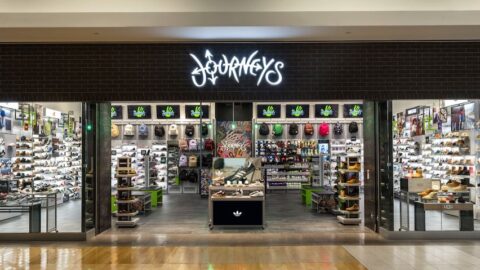Malls are coming off the holiday season on a high — despite years of stories about the demise of the shopping center, consumers ventured to the mall in droves to cross items off their shopping lists and enjoy the spirit of the season. For example, visits to indoor malls on Super Saturday (the last Saturday before Christmas, which fell on Dec. 21 in 2024) increased a whopping 177.1% compared to 2024’s year-to-date daily average, according to foot traffic intelligence platform Placer.ai.
Perhaps even more surprising than the mall’s comeback is the group of consumers driving it — digital-native Gen Zers, who were widely expected by their jaded older brethren (that is, those of us over the age of 30) to eventually shuck in-person shopping altogether in favor of ecommerce. But it turns out that, like every young generation before it, Gen Z enjoys socializing. Perhaps, then, it shouldn’t be such a big surprise that they are rediscovering the age-old teenage joy of the “mall hang.”
“Retailers and developers once feared Gen Z and Gen Alpha, and what their digitally native ‘i-fingers’ might mean for the bottom line,” said Tyler Winograd of design firm Gensler. “For years, brands worried that these generations of shoppers would quickly forget brick-and-mortar retail in favor of the ease and convenience of online shopping. While their social and shopping experiences likely originate online (TikTok, Instagram, Snapchat), they don’t end there. These generations have made clear their desire to experience those digital connections ‘IRL.’”
But (and it’s a big but), to effectively capture the attention of these generations, malls have to evolve beyond the traditional “warehouse of stores + food court” model. Retail TouchPoints gathered insights from experts across the store design, experience, real estate and technology realms to find out how and where developers and retailers should be focusing their mall strategy. The panel of experts includes:
- Jamie Cornelius, Executive Creative Director, ChangeUp
- Melissa Gonzalez, Principal, MG2, and leader of MG2 Advisory
- John Mercer, Head of Global Research, Coresight Research
- Kyle Spencer and David Blumenfeld, Co-founders, NextRivet
- Tyler Winograd, Retail Studio Director, Gensler
Trend 1: Becoming More Than Just a Place to Shop
While ecommerce hasn’t overtaken in-person shopping as was once feared — 77% of total payment volume this holiday season took place in stores, according to Visa — retailers and property owners are well aware that they must evolve to account for the realities of shopping today. That means creating spaces that do what ecommerce can’t.
Spencer: Traditional foot traffic has taken a hit in some areas, thanks to ecommerce and changing shopping habits, but it’s far from doom and gloom. A lot of malls are stepping up their game and becoming more than just places to shop — they’re turning into full-on destinations. Think dining, entertainment, events and those experiences you can’t get online. That’s what’s really driving success — creating spaces that feel relevant and valuable to the people they serve across life, work and play.
Winograd: Malls and shopping centers still serve an important purpose in today’s shopping, entertainment and social cultures, but they are rapidly transforming themselves to find new relevance aligned with the current state of the world.
Malls are now occupying two clearly distinct spaces — luxury retail supported by luxurious shopping and beacons of entertainment. [What sets] the higher-end destinations apart is their commitment to end-to-end hospitality, thoughtfulness and true experiential shopping. Some of the most successful places — like Rick Caruso’s The Grove and Scott Malkin’s Belmont Park Village — are rooted in luxury hospitality, with champagne-accompanied shopping, personalized concierge services, integrated apps (not just a map) and order-ahead options, in addition to many more a la carte hospitality features.
The entertainment-focused destinations are oriented toward families and shoppers alike and are designed to captivate an audience for a full day of activities. The “entertainment economy,” popularized by Taylor Swift’s recent GDP-worthy tour, is a symptom of a greater societal trend — post-Covid and current digital rebellion has led people to remember their innate desire for collective effervescence and in-person experiences. The mall-movie theater [combo] may have started it all, but today we see physical-digital immersive experiences, sporting activities like ice skating, axe throwing and even skiing, in addition to “pop-up” branded experiences like Harry Potter World and the Museum of Ice Cream now occupying space within the confines of a “mall.” American Dream, Ovation Hollywood and even Related’s Hudson Yards all are aiming to fill this void.
Trend 2: Ditching the Word ‘Mall’
Every generation has its lingo, and as malls evolve beyond their traditional model, we might very well need a new term to describe these multi-purpose destinations.
Cornelius: The cautionary tale of shopping malls was that they became dated and irrelevant to the public. Even calling them “malls” feels outdated. We should stop thinking of them as malls. Ultimately these are mixed-use developments that should be referred to as “lifestyle centers,” “community marketplaces” or “experience hubs.”
Mercer: Over the coming years (not just in 2025), we expect top-tier malls to accrue a greater share of total mall-based consumer spending, driven by shoppers’ desire for premium experiences. Retailers will want footholds in the best malls and lower-tier malls will close or turn into non-retail locations.
A consolidation of retail share among top-tier malls also will strengthen the market positioning of their parent companies, bringing with it several advantages, including the ability to compete more fiercely in the market. During this time, higher-tier malls will continue to invest heavily in experiential retail, such as upscale dining and entertainment options, attracting new consumers. While the character of the mall will remain retail-centric over the coming years, we expect mixed-use elements — such as hotels, apartments, co-working spaces and gyms — to be prominent features of the mall of the future.
Blumenfeld: “GLA [gross leasable area] Diversification” is a term we’ve been using lately to describe the shift in how shopping malls and centers are evolving. This trend is about creating well-rounded destinations where people can shop, socialize, exercise and even access services they might not have expected in a mall environment.
Fulfillment also will be a key driver of innovation. With the rise of ecommerce, we expect to see more integration of fulfillment solutions within malls — whether it’s dedicated spaces for click-and-collect, micro-warehouses or same-day delivery options. In 2025, the most successful properties will be those that offer seamless integration of these new services, blending digital and physical in ways that enhance both convenience and engagement.
Trend 3: Keeping up with Gen Z (and the Generations that Follow)
Perhaps more than any previous generation, it’s becoming clear that Gen Z needs the mall. For a group that is spending more time than any previous generation engaging in life virtually, a great mall can provide an almost irresistible opportunity to satisfy that natural human urge for physical interaction. And we can expect similar impulses from the generations coming after them: Gen Alpha, which is just beginning to arrive at prime “mall hang” age, and Gen Beta, the first members of which arrived at 12:01 am on January 1.
Spencer: We’re seeing more and more brands adapt to what younger generations want — whether it’s offering flexible store formats, leaning into experiential retail or creating that seamless online-to-in-store connection. When the retailers step up their game, it pushes the whole ecosystem forward, making malls and shopping centers more relevant and exciting.
Gonzalez: [Our recent Gen Z report] showed that Gen Z and Gen Alpha value in-person experiences. The top three drivers behind their decision to shop in-store instead of online were the same for female and male Gen Z consumers — one, to try on in-person (73%); two, to touch or feel in-person (72%); and three, to view a brand’s products in a different way (44%). Gen Z appreciates quality, and the store environment gives them the opportunity to test and learn if the product performance they are hearing about online is worth their investment. Given that, some strategic considerations for 2025 include:
- Utilizing consumer behavior analytics to tailor offerings and experiences that meet the evolving preferences of Gen Z and Gen Alpha;
- Designing more adaptable environments with the ability to host pop-ups and events with ease; and
- Remaining attuned to cultural trends and social media influences that impact the preferences of these demographics
Mercer: Recent Coresight survey data also revealed a correlation between age and the type of shopping centers that consumers visit: Younger adult consumers are more inclined to visit enclosed malls, while older generations skew toward open-air shopping centers. Our data showed recent adult visitation to enclosed malls peaks at 45.7% among millennials (aged 30-44), followed by 42.5% among Gen Zers (aged 18-29).
Trend 4: Technology and Bold Tenant Mixes will Drive Experience Innovation
Technology is playing an increasingly large role in physical retail, and malls are no exception. And it’s not only retailers getting in on the high-tech action; property owners are increasingly looking for ways to unify and enhance the experience at their destinations.
Gonzalez: The most forward-thinking developers create a holistic journey for visitors, ensuring that the transition between experiences and shopping feels natural and enticing. Merchandising plays a critical role here; the layout and tenant mix must be thoughtfully curated to align with consumer preferences and behaviors.
Top-performing “Class A” destinations exemplify this approach by employing a strategic mix of anchors that consistently drive traffic, engagement and longer dwell times. These centers focus on adjacencies — pairing complementary stores and services to enhance convenience and discovery for consumers.
Winograd: Developers and brands have to move beyond the dated idea of omnichannel and instead focus on elevated convenience and differentiation. Yes, our reliance on and comfort with ecommerce has forever changed our relationship with shopping, but it hasn’t eliminated it. Instead, it’s raised our expectations for basic components — ease of finding a product, checkout process, wait times and personalization. These core elements are what have to be translated into the physical experience to get people in the door and, more importantly, guarantee they come back.
The in-store re-creation of the digital experience was foolish, but it revealed the importance of differentiation — differentiation from your competitor and the neighbor next door, yes, but more importantly, differentiation from your online experience. Mall offerings can provide products and experiences that can only be experienced in person, and likely on a limited basis. Tutorials, product demos, collaboration launches, celebrity and influencer appearances are all tactics that are gaining traction and seeing success.
Blumenfeld: Some of our clients have implemented strategies around understanding their customers better through tools like single-identity platforms, customer relationship management [CRM] systems and customer data platforms [CDPs]. These technologies allow for personalized, right-place, right-time messaging that resonates with consumers on a deeper level. When combined with curated in-person experiences, they create a seamless and memorable journey for visitors. That’s where we’ve seen the most impact — when physical spaces and digital tools come together to meet customers where they are and anticipate what they need.
Trend 5: Reimagining Malls’ Role in the Omnichannel Journey
As shopping behaviors evolve, retailers must reassess the role their mall store plays in their customers’ lives, which opens up opportunities both on the functional side of the equation (for example, ecommerce-related services like returns) and on the aspirational side (in the form of inspiring, experiential moments that won’t translate through a screen).
Cornelius: Retailers need to think about how their stores don’t just sell, but also support online shoppers, such as using physical locations for order pickups and/or returns. The key is to be strategic about location, customer engagement and integration with digital experiences.
With so many restaurant, retail and entertainment venues vying for customers’ attention, winning the visit is the number one goal. ChangeUp’s recent work with Vera Bradley was about reimagining the experience to appeal to a younger audience. That started with creating both an impactful storefront that showcased the brand while also showcasing storytelling and product collections right upon entry. It meant foregoing the typical fixturing and creating a proper stage to draw customers in and engage with the product. Retailers have to reimagine how they’re able to grab the attention of customers.
Blumenfeld: Retailers have been reducing the glut and duplication in their portfolios for years — well before COVID — with fewer stores needed in each community. Now, they’re making more thoughtful decisions about which properties offer the best chance to connect with shoppers. Properties that are investing in services or programs that are supported by technology are going to be the places retailers want to stay in their portfolios.
Winograd: Demographics still rule the game of retailer location selection. Are your current and/or target consumers there? First and foremost, the answer still needs to be yes. However, the next generation of malls and shopping centers, combined with an emerging culture of shopping renaissance, have elevated new, equally important factors:
- Outdoors. Humans relearned the importance of fresh air and sunlight in 2020, and that experience has carried into every facet of life — office buildings, sports and entertainment, airports and travel and shopping.
- Partnerships. Brands and developers have realized that everyone succeeds together. Brands are looking for an active developer/owner that can offer beneficial partnership beyond a favorable lease — apps, promotions, access to consumers and data, and likeminded brand alignment with other retailers.
- Options. Whether leaning into hospitality or entertainment, there needs to be a clear “more” attracting customers, because plain old shopping is now done on the internet.
- Food. If consumers are going to make the trip, they want (demand) exciting, relevant and differentiated dining options.















